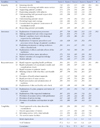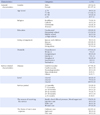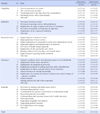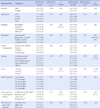Abstract
Purpose
This study was attempted to provide quality improvement and revitalization of visiting nurse services by Importance-Performance Analysis of persons being provided with the services.
Methods
The subjects were 350 people being provided with visiting nurse services from a long term home care institution in the kangwon Province during the period of data collection between Aug. 16 and Sep. 15, 2011. Data analysis was conducted through t-test, ANOVA, and IPA by using the SPSS/WIN 12.0 program.
Results
As a result of the Importance-Performance Analysis of visiting nurse services, it turned out that the strength on reliability, assurance, and empathy should be maintained with good work and the aspects of responsiveness appeared to be intensively improved, and the tangibility proved to be subject to improvement.
Figures and Tables
References
1. Bacon DR. A comparison of approaches to importance-performance analysis. Int J Mark Res. 2003; 45(1):55–71.

2. Choi HY. A study on post-hospital home health care needs in a general hospital. Jeonju: Chonbuk National University;2001. Unpublished master's thesis.
3. Cronin JJ Jr, Taylor SA. Measuring service quality: A reexamination and extension. J Mark. 1992; 56(3):55–68.

4. Ellen WL. Using importance-performance analysis: Importance-performance analysis is a simple tool which yields easily understood data with many uses. J Nurs Manag. 1990; 21(5):20–25.
5. Jeong GH, Kang HY. Knowledge and perceptions on visiting nursing service needs among workers in long-term care insurance institutions. J Nurs Sci. 2009; 14(1):119–130.
6. Joo MK. A study on the determinants of consumer-oriented nursing service quality. J Korean Acad Nurs Adm. 2002; 8:169–191.
7. Kang Y, Ha YM, Eun Y. Health status and health-promoting lifestyle profile II of north korean immigrants. J Korean Acad Community Health Nurs. 2012; 23(3):231–243.

8. Kim BY. Comparison studies on the effectiveness of gardening, music, and art therapies conducted as nursing interventions for imbecility: Mainly concentrated at rehabilitation nursing program. Korean Nurse. 2001; 40(1):51–63.
9. Kim KS, Ha EH. Factors affecting quality of nursing services and intention to revisit as perceived by hospitalized patients and nurses in medium sized urban hospitals. J Korean Clin Nurs Res. 2009; 15(2):103–114.
10. Kim MH. Roles of visiting nurses defined based on long-term care insurance regulation for the elderly. J Korean Acad Public Health Nurs. 2009; 23(2):232–250.
11. Kim SJ. Path analysis of religious activity effect on the quality of life of the elderly. J Welf Aged. 2006; 33:29–50.
12. Kwon DK. The study on the plan of improving the service quality in the food industry by the IPA matrix. Korean J Tourism Res. 2011; 26(1):1–31.
13. Kwon MO. Plan to boost long term care system for elderly in Korea. Busan: Dongeui University;2003. Unpublished master's thesis.
14. Lee AJ, Sin KL, Sung MS, Park YH, Hong MS, Lee PS. Performed the first anniversary of long-term care insurance visiting nursing service policy debate for the activation. Seoul: National Health Insurance Corporation;2009.
15. Lee JS, Han EJ, Kang IO. The characteristics and service utilization of home nursing care beneficiaries under the Korean long term care insurance. J Korean Acad Community Health Nurs. 2011; 22(1):33–44.

16. Lee JS, Cho SO. An empirical study on the influence of customer satisfaction and intention to reuse by pharmacy service quality and characteristics. J Korea Manag Eng Soc. 2011; 16(1):1–18.
17. Lee MA. A study on the differences of perception between consumers and providers about nursing service quality, and the usefulness of tools measuring nursing service quality. J Korean Acad Nurs. 2000; 30(5):1121–1132.

18. Lee MA. A study of the nursing service perceived by consumers and providers, and the tool that measures nursing service. J Korean Acad Nurs. 2003; 33(6):772–783.

19. Lee MA. A study of the nursing service quality and gap perceived by consumers. J Korean Acad Nurs. 2004; 34(2):225–234.

20. Lee MK. Job identification of home visiting nurses based on long-term care insurance for the elderly program. Seoul: Hanyang University;2010. Unpublished doctoral dissertation.
21. Lee YH. A study on characteristics of long stay hospital patients and home health care needs. Seoul: Chung-Ang University;2005. Unpublished master's thesis.
22. Long Term Care Insurance for Elderly. (Ta) Partial revision, 2011. 12. 31 law institution 11141. long term care insurance for elderly. 2011. Retrieved December 24, 2012. from http://www.law.go.kr/DRF/lawService.do?OC=lrzh&target=law&MST=120495&type=HTML&efYd=20120901.
25. Ministry of Health & Welfare. The standard text of care worker. Seoul: Author;2008.
26. Ministry of Health & Welfare. 2011 health and welfare white paper. Seoul: Author;2011. from http://www.mw.go.kr/front_new/jb/sjb030301vw.jsp?PAR_MENU_ID=03&MENU_ID=030503&CONT_SEQ=278200&page=1.
27. Paik NJ. More than half of old people complain of a pain. 2009. Retrieved May 31, 2013. from http://health.chosun.com/site/data/html_dir/2009/12/28/2009122800668.html.
28. Parasuraman A, Zeithaml VA, Berry LL. SERVQUAL: A multiple-item scale for measuring consumer perceptions of service quality. J Retail. 1988; 64(1):12–40.
29. Sung YH, Kwon IG, Kim MK. A study on the perception gap in clinical nursing service between customers and providers. J Korean Clin Nurs Res. 2006; 12(1):109–123.




 PDF
PDF ePub
ePub Citation
Citation Print
Print








 XML Download
XML Download